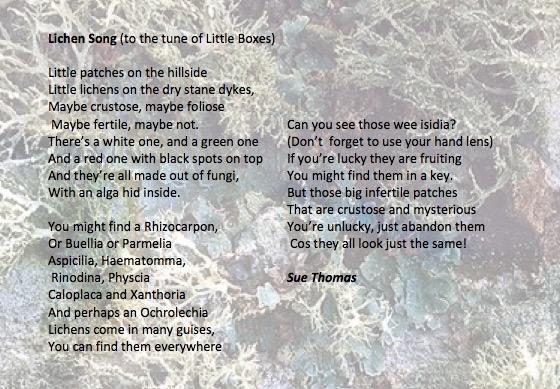
18 minute read
East Lothian (vc82) Botany Group
After working out the monads with no records and marking them on my phone Memory Map with a blue flag, and monads with less than ten records with a yellow flag, we concentrated on these through the Spring moving eastwards through the county. Spring plants such as Petasitesfragrans (Winter Heliotrope), Myosotisramossissima (Early Forgetmenot) and Viola odorata (Sweet Violet) were particularly targeted. On a walk down the Colstoun Water, we refound quantities of Petasites albus (White Butterbur), and an unusual plant Trachystemon orientalis (Abraham, Isaac and Joseph) which has naturalised down this river.
Michael Williams, owner of Eaglescairnie farm near Gifford, asked the Botany Group to come and record around his farm, as he takes a keen interest in natural history. There is a regular group who visit to record the birds, and Michael has brought in students to practise the layering of hedges. A small group of us made visits in the Spring and Summer. The Ladies Tresses which grow nearby are just outside his farm but the damage caused by storm Arwen with fallen trees had not affected them. He felt that the layered hedges and the mixed planting of trees had been beneficial to the farm’s biodiversity.
Advertisement
At the end of July, a group visit was made to Papple Steading near Whittinghame. Sue Jury undertook to lead this visit, as an operation on my foot kept me away from recording for the rest of the Summer. The aim of the visit was to learn about the exotic trees that grow in the Whittinghame woods. To add to the interest, George Mackintos h is developing Papple Steading into an East Lothian agricultural museum and went out of his way to welcome the group and show them around the buildings and the wildflower meadow, ending up with a welcome tea.
This is my opportunity to thank Sue Jury for all her hard work in helping the recording in VC82; she has now become Recorder for VC83, and we shall work closely together. For 2023 we are planning some shared walks between the two counties. Some records are listed with photos for the digital version.
Marion Moir
Kirkcudbrightshire Botany Group (KBG)
Initially suggested in 2013 by another BSBI member here, I was finally persuaded –somewhat reluctantly I admit – to set up a group in 2014, expecting 5 or 6 at most. However, at the first field meeting April 16 botanists turned up and it’s been thriving ever since. At the latest count there are 52 participants, not all active but certainly interested. We started off with one meeting a month, 9 in the first year, and now regularly hold around 15, roughly every fortnight. Each has a specific purpose depending on what needs doing, what species or habitat we would like to see, the best sites, and those previously unvisited or with very few records over the 3 Atlas periods; plus training days (grasses; sedges; rushes; ferns, as requested). The aim however is to combine this with enjoyment and learning about plants.
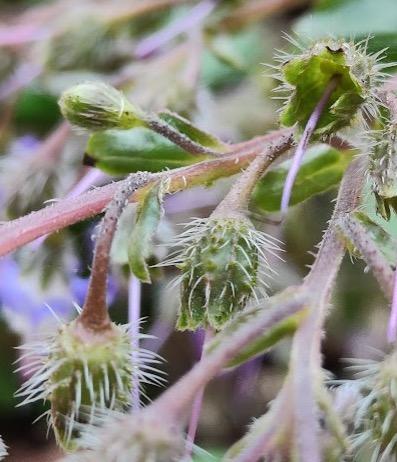
Organising and running the meetings has been a labour of love - a team is gradually forming with designated photographers, card recorders and subsequently data entry people, to help with the administrative side. A few dedicated individuals tackle monads local to them each year. In all, we produce around 5000 records annually. To maintain support and encourage interest, all members are circulated with field meeting reports and, during Covid lockdown, with monthly Newsletters about items of interest – recent finds, identification sheets and links to other simil ar or useful sites.
We’ve been involved with TPP, SHARPP, NYPH, site monitoring, advising bodies (like RSPB, SWT, NTS, MOD), landowners, and private individuals wishing to enhance their environment. We’re monitoring several rarer species, notably Meum athamanticum,2Zostera spp.,Silene viscaria,Ophyrisapifera,Carexelongata,C.punctata, Thelypterispalustris, etc. – one or two with population data going back to 1947! There have been many NCRs since 2014, unexpectedly including Pimpinellamajor, Echinocloa crus-galli,Spirodelapolyrhiza,Spiranthes romanzoffiana,Filipendulavulgaris, Imperatoriaobstruthium, Stellarianeglecta and a host of aliens.
And significant re-finds of old records, mostly last seen pre-1900 - Sedum villosum (under threat from forestry), Epipactishelleborine, Neottia nidus-avis Birdsnest Orchid
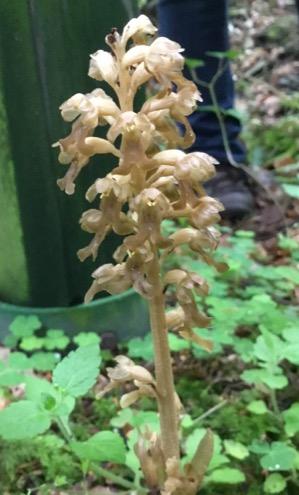
(© David Hawker),Ranunculussardous,Daturastramonium,Sempervivumrupestris, Persicariavivipara,Oxyriadigyna – this last a 1935 record hinted at by John Raven in the New Naturalist “Mountain Flowers” but without definite details and not officially accepted, and Althaea officinalis (probably at its original recorded site in 1883).
Despite being a botanical group, the expertise ranges through lichens, fungi, aquatic invertebrates, various insect groups, birds and so on; these records usually find their way to the South West Scotland Environmental Information Centre. Some of our good plant sites have also been excellent for rediscovered or newly discovered (NCRs) species of rare or scarce aquatic invertebrates and spiders.
There’s still lots to do in the c oming years . . . and plenty of interested people to do this.
David Hawker Recorder for VC 73
Field meeting, Almorness PeninsulaPalnackie, Aug 2021 ©Lee Paton
Dumfriesshire Botany Group at Langholm, 17 July 2022
On a fine day ten off us met at the cemetery and walked across Skippers bridge to access two squares on the SW slopes of Whitta Hill. This is now mostly within the Tarras Nature Reserve owned by the community and so the survey results will be passed to the reserve team as part of helping them build up an understanding of what they have. The two squares included land within and outside the reserve and these areas were recorded separately. They had a combination of wooded riverside, woodland on the lower slopes and along the old railway and open hill with bracken and scrub higher up. Some flushed areas supported richer grassland otherwise the slope has a heathy vegetation.
The wooded areas, a mix of decid uous and conifer species are not particularly rich suggesting that they are relatively recent in development and supplemented by planting. A few plants like Wood - sedge Carexsylvatica,Remote Remote Sedge Carex remota and Hairy - brome Bromopsisramosa suggest that there might have been remnant older wooded sections and below the minor road the wooded riverside is more natural.
Once on the open ground the acid nature of the slope was evident with a mosaic of bracken and heath. In the more open areas heathy species like Wood Sage Teucrium scordonia, Heather Callunavulgaris, Bell Heather Erica cinerea and Velvet Bent Agrostiscaninasl. were dominant. In some of the shorter vegetation we found not only Sheep’s - fescue Festuca ovina and Heath Grass Danthonia decumbens but also the very needle leaved Fine - leaved Sheep’s - fescue Festuca filiformis. This probably gets overlooked in this kind of habitat but is worth looking for. Compared to Sheep’s Fescue its flower parts are smaller and lack awns but in the field the very fine long leaves are the first thing to spot.
There were places where water seepage brought more neutral conditions and these were shown up by the presence of species like Marsh Thistle Cirsium palustre and Burnet - saxifrage Pimpinellasaxifraga. These had patches of Wild Thyme Thymusdrucei and species like Marsh Arrow Grass Triglochinpalustre and Flea Sedge Carexpulicaris. It was around the margins of these damper areas that Carol was the first to spot Adders - tongue Ophioglossum vulgatum (© Sarah White). This is a little fern with a single fleshy diamond shaped sterile leaf blade generally 5 to 15cm and a narrow fertile blade eventually longer than the sterile leaf, carrying a spike with sporangia (the adder’s tongue). It is recorded as having the highest number of chromosomes in any British plant (500 -550).
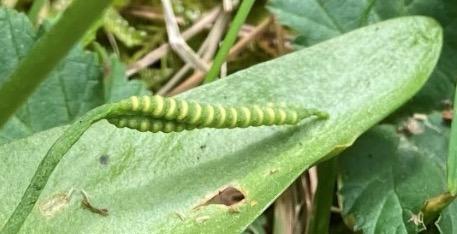
Until this year this was thought to be a rare plant in Dumfriesshire but this population is now the seventh new population found this year. Three of these have been in the hills around Langholm. Previous to this year it was last recorded in the Langholm area in the nineteenth century so it is great to find that it has survived unrecorded over 150 years. There were several places where we found it in the first square so there is a good population on this slope and a chance for it to be found elsewhere. Like Moonwort, Adder’s Tongue is indicative of an unploughed and unfertilized old grassland.
The southern square that we looked at had a similar range of species though as much less of this is open heath we did not find Ophioglossum. There were some good sized oak trees in Long Wood itself and markers had been placed by young seedlings which look set to be used to extend tree planting on the reserve.
Chris Miles VCR Dumfriesshire VC73 – bsbi.org/dumfriesshire
Strathtay Botany Group
Early in 2022 there seemed to be a demand for a local botany group among people who appreciated the local flora without having much knowledge or expertise in botany. So this group is not – or, at any rate, not yet! – a recording group. It doesn't have an advance programme, there is no committee or constitution and no website. We operate through a WhatsApp group on which people post interesting finds, ID queries, and general botanical questions. Of the current 17 members, three are (or were) VCRs, several are novices, the rest of us in between.
Also posted on WhatsApp are suggestions for meeting up at a nearby place on a nearby date. These informal meetings can take any form, and we began on 1st April with a visit to Weem Meadow SSSI, a traditional hay meadow by the T ay in Aberfeldy. We were chiefly monitoring the state of Yellow Star of Bethlehem Gagealutea because there had been concerns about the grazing management after a change of ownership of the site. However, the Gagea was in fine form – indeed, in places we could hardly move a pace without trampling some!
Several members joined the BSBI Training meetings at the Tummel Shingle and Ben Lawers and we met in Glen Fender in July to look at orchids, finding five out of the ten orchid species recorded here. In August, one of our least experienced members posted a rather distant shot of a plant that she said was abundant in a piece of forestry waste ground, and suggested it might be Common Centaury Centauriumerythraea. It looked possible – but in that habitat? But it was so: we counted at least 100 plants absolutely carpeting an area of c.100sqm. This was used for turning by forestry vehicles, so presumably it was brought in on their wheels and, finding no competition, simply took over the ground.
Faith Anstey
Angus Hannah's bramble group
Since the first meeting in Bute in 2017 a small, evolving group has met for a weekend workshop in succeeding years in Glencoe, Hamilton, Kirkcudbright, Helensburgh and Lochwinnoch. This year we also held a one-day meeting for beginners in brambles, and this may be repeated if there is interest. Numbers have to be limited, but anyone with an enthusiasm for brambles is invited to book early. We are planning to hold next year's meeting(s) in Maybole.

Moray botany group
I started the Moray Botany Group in 2009. The aim of the group is to get more local botanists to know the whereabouts of the rare and interesting species found in Moray. A number of field meetings are held each year, with an email sent out about a week before the meeting with details of meeting place, species we are going to look for etc.
Ian Green igreen67@aol.co.uk
Erudite Epithets
Even if you haven't got what used to be called 'the benefit of a classical education' it can be useful and entertaining to know the literal meanings of the epithets used in scientific names. Here are some descriptions of leaf characters – can you match them up with their vernacular meanings?
aculeatus awl-shaped caudatus kidney-shaped ceraceus with a long tail cernuus gnawed-looking corniculatus prickly erosus polished incanus hoary laevigatus bellying lanatus waxy nutans whorled pruinosus horned reniformis one-sided secondus nodding subulatus drooping ventricosus woolly verticillatus frosted


Seeing The Wood For The Trees
As you can see, these are all pictures of leaves from trees. What's the quiz? Well, you have to work that out yourself! But if you can identify all the trees (vernacular names) you may find you have come up with an eponymous tree.
Puzzle Solutions
SOLUTION TO CROSSWORD No. 7
Across 1. ORDER 4. POLICY 8. STRUDEL 9. POLAR 10. EMMER 11. ENDEMIC 12. PEARLY
14. PRESTO 17. ALLHEAL 19. CILIA 21. TONED 22. SINUATE 23. GOURDS 24. SPART
Down 1. OYSTERPLANTS 2. DURUM 3. RUDERAL 4. POLLEN 5. LIPID 6. CALAMUS
7. ERECTO-PATENT 13. AILANTO 15. RICINUS 16. CLOSES 18. ELDER 20. LIANA
CRIB
Across 1. double definition 4. dd 8. anagram SLED RUT 9. PO(P)LAR 10. EM/MER(E)
11. END/EM/IC 12. Pearly Everlasting/Pearly Gates 14. pressed/O 17. charade 19. sillier 21. reversed in maDE NOTes 22. anag IN USE AT 23. anag DUG ROSE 24. SPART(AN)
Down 1. (B)OYS/ anag SPLATTER round N 2. D<U>RUM 3. RUDER/AL 4. POLL/sEeN
5. LIP/ID 6. musiCAL A MUSical 7. anag CANT(H)ETREETOP 13. AIL/AN'/TO (Tree of Heaven)
15. RICe/IN/US 16. CLOSE/S 18. (GU)ELDER 20 D*IANA
Word Search
ACHENE, ANTHER, ARIL, AXIL, AWN, BIFID, BLADE, CARPEL, CONE, CYME, CORONA, DISTAL, DRUPE, DECUMBENT, DISC, ERECT, GLAUCOUS, GLUME, GLAND, HAIRY, HISPID, KEEL, LAX, NAKED, OPPOSITE, PANICLE, PALMATE, PEDICEL, PERIANTH, RAY, SCARIOUS, SINUS, SPIKE, TAXON, TEPAL, UTRICLE, VEIN, WING
Erudite Epithets
aculeatus – prickly, caudatus – with a long tail, ceraceus – waxy, cernuus – drooping, corniculatus – horned, erosus – gnawed-looking, incanus – hoary, laevigatus – polished, lanatus – woolly, nutans – nodding, pruinosus – frosted, reniformis – kidney-shaped, secondus – one-sided, subulatus – awl-shaped, verticillatus – whorled, ventricosus – bellying.
Tree Quiz
Rearranged, the vernacular names of the trees give you
D ogwood (7)
O ak (4)
U mbrella tree (2)
G inkgo (6)
L arch (5)

A spen (1)
S ervice tree (3)
AlistairGodfreyhadbeenVCrecorderforMidPerthshiresince2003when,afteralong illness,hesadlydiedon7December2022.
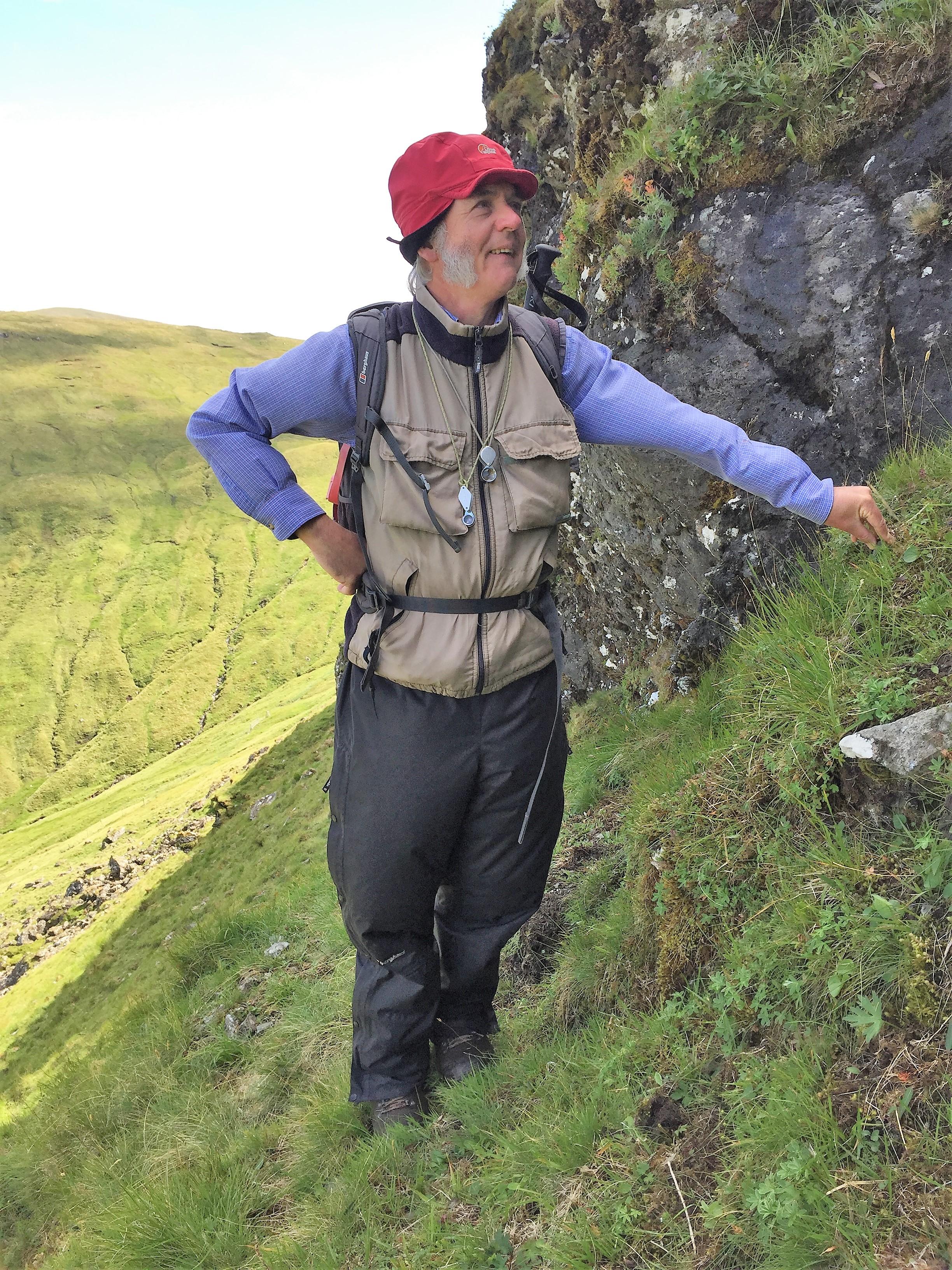
I knew Alistair since about the year 2000 when he become chair of the PSNS Botanical Section. He also served time on the BSBI Scottish Committee and had been VCR for Mid Perth since 2003. Over the years he led very many field excursions, a number of which were dedicated to introducing newcomers to the delights of botany. It was always fun to go botanising with him and frequently gave me new insights into how to identify even the commonest of species. He was a brilliant botanist with an eye for unusual and rare plants, willing to tackle the most difficult plant groups – dandelions, brambles, and particularly roses. He should also be remembered for his outstanding conservation survey work. He used his professional planning expertise in meticulous research to object to damaging planning applications. His submission was key to getting the Glen Quey Quarry application refused by the Scottish government: he proved the Moss was a perched raised bog in recovery, an exceptional habitat, described as ‘impoverished pasture’ in the official EIA. He also fought hard to stop the Ochil Hills being blanketed in Sitka Spruce. He fought tirelessly for the preservation of sensitive, priority habitats.
He knew his vice-county Mid Perth intimately and had an enviable mixture of focus and gentle charm. He was also a right minded person who believed in fairness and justice for all. I feel very privileged to have been his friend.
Liz Lavery VCR West Perthshire
I think one important thing Alistair deserves recognition for is his investigations of the historical ecology of local woodlands, particularly his 2018 StudyoftheWoodsand WetlandsatBerthaPark,Redgorton – at 176 pages, far more in-depth, better informed and interesting than the brief and superficial report produced by the consultants paid by the developers for the same area. Around the same time, he also produced a shorter study of one of the woodlands on the outskirts of Scone, Reports of his studies of two woodlands near Methven and Den of Methven were the last of numerous articles he wrote for the PSNS Bulletins, which are all available to download from the PSNS Publications page www.psns.org.uk/psns-history.
Colin McLeod

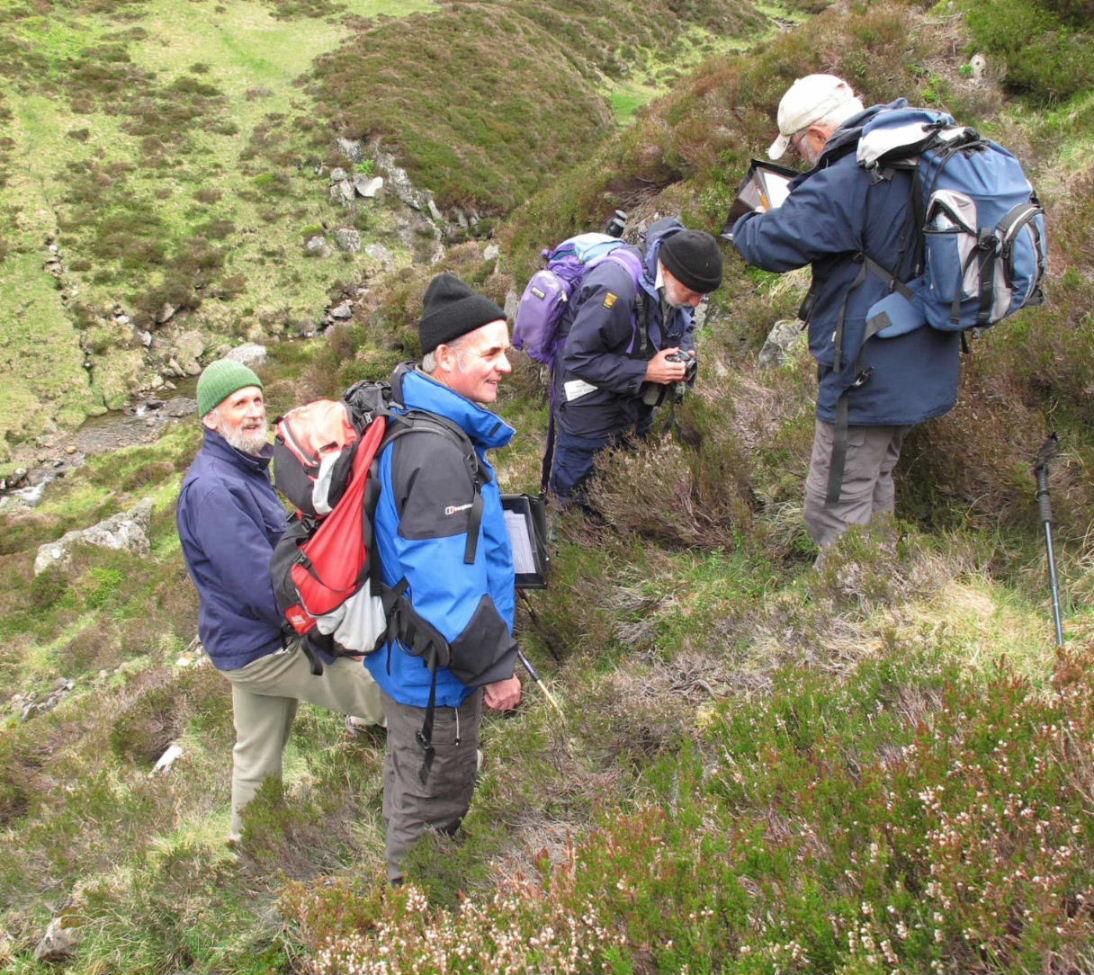
Sedum villosum , Kirkcudbrightshire
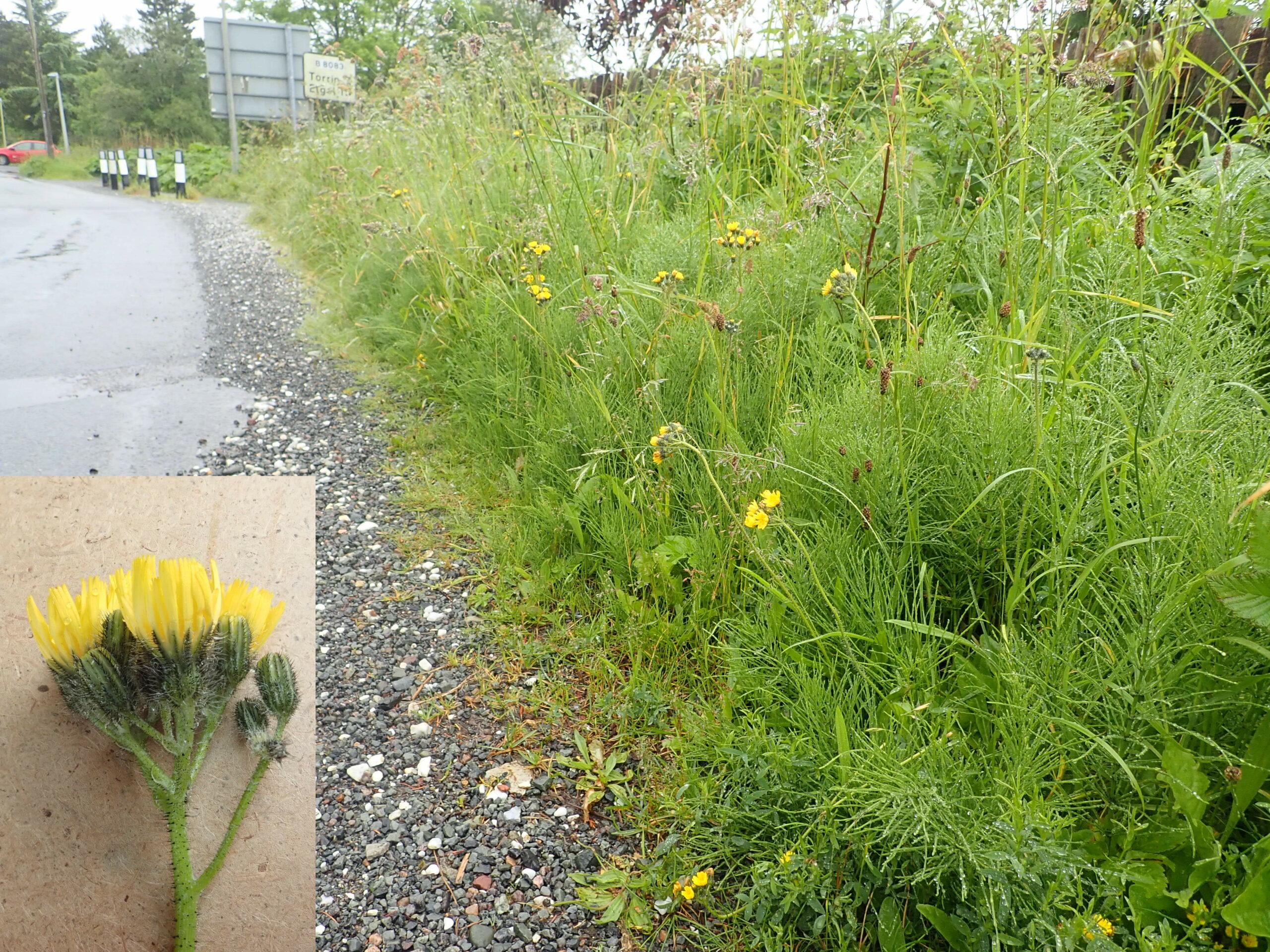

©Jan Davidson
– see page 43
Berriedale

One of the entries in the Photographic Competition 2022 (NB The winners were all English – Scotland: must do better!)
Purple Saxifrage Saxifragaoppositifolia © Bert Barnett Page 15
Do you suffer from kleidophobia? Put it this way: if you were told to consult a key from scratch in Stace, Hubbard or Francis Rose, would you rather clean the kitchen floor with a toothbrush?
This is kleidophobia – fear of keys. It is a very common complaint among novices in all the biological disciplines. When you look at keys like those below, it is no wonder many people (and not only novices) take fright.
This is an example of a dichotomous key. One of the reasons they look so frightening is that they have to be exhaustive, i.e. they have to cover every possibility, every plant that might come up. So they need to allow for all kinds of weird and wonderful features that someone might be interested in, such as a plant without petals, or one growing completely underwater, or one with male and female flowers on separate plants and so on. They also have to use very exact terminology – which means you seem to spend a lot of your time buried in the glossary.
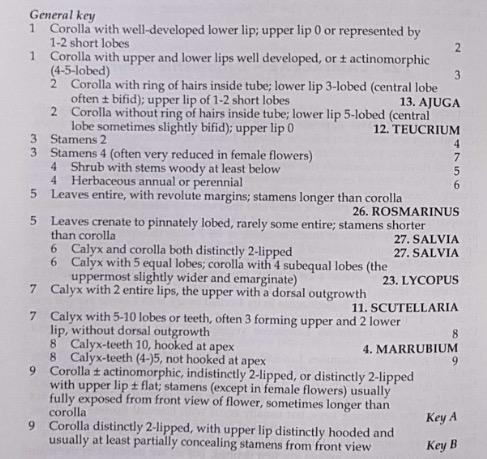
Another kind of key is the multi-access key. Here you are presented with a list of features such as (in a grasses key) ligule pointed, leaves hairy, inflorescence a spike, awns present and so on. You list all the features your plant possesses and then find the nearest match in a table. I don't know many people who find these awfully helpful in books. However, online where you just tick boxes and a programme does the work for you, it is much easier. Keys developed by Lucid lucidcentral.org are excellent here, but they are mostly concerned with plants and bugs that are economically or ecologically undesirable. The BSBI's botanicalkeys.co.uk works on a similar principle.
However, the dreaded dichotom ous keys can also be used by novices once you understand how they work. The idea is that you choose between two alternatives in a 'couplet': e.g hairy leaves vs. hairless leaves, or notched petals vs. unnotched petals. The alternative you choose will lead you to another couplet and so on.
Awordofwarning:'dichotomous' issupposedtomeanthatyouareofferedachoiceof twoalternatives.Bewarethough:inHubbardthetwoalternativesmaybeseveralpages apart,andinRosetherearesometimesthreeor more options.
Here's a simple example where only three species are at issue (so not exhaustive). The task is to distinguish between three red poppies. the only character used is the seedpod This is sufficient to distinguish between these three, though of course, it wouldn't do if more species were involved.
1a Seedpod smooth . . . . . . . . . (go to) 2 b Seedpod bristly . . . . . . . .. . . . . . Rough poppy Papaverhybridum
2a Seedpod round . . . . . .. . .. . Common poppy Papaver rhoeas b Seedpod long and thin . . . . Longheaded poppy Papaverdubium

If you can follow this, you have grasped the idea of keys, so it's now only a matter of practice. You are cured of kleidophobia!
Some tips
1. Make sure you have studied your plant carefully before you begin. Even write down a list of the salient features such as number of petals, shape and arrangement of leaves and so on, so that you can run through the questions smoothly. For Stace, you w ill see that when you get to the majority of ordinary flowers (known as 'herbs') you will need to know whether petals are fused or free, ovaries superior or inferior and so on, so if you find these distinctions tricky, work on that before you start on the key.
2. If you know roughly what sort of plant you have, you may decide to ignore the general key and go straight to the key for a particular family or group. The more ID practice you get, the easier it will be to do this.
3. Whatever level of key you are looking at, scan the whole thing first and see if you can suss out the master plan. In Hubbard, for example, Couplets 2 to 35 are all about grasses with spike inflorescences; those with panicles don't begin until couplet 36. In Rose, key A is about aquatics, B is about composites, C is mostly graminoids and some trees and so on. This will save ploughing through sections that aren't relevant to your enquiry.
4. If you still feel intimidated by the keys in these 'bibles' of botany, go back a stage a nd look at some beginners guides to ID first, where you may get help in finding families, understanding more complex concepts, or knowing which features are important for ID and which you can safely ignore. Good luck!
Beginning to botanise in Scotland
It's the Botanical Society of Britain & Ireland we be long to, and when you start to botanise in Scotland, you can't escape the fact that your ID books and field guides –Stace, Rose, Poland, Collins or whatever – cover the whole of the British Isles. You may be lucky enough to have a county Flora for a particular area, but how can you get an overall view of where the flora of Scotland fits into the flora of Britain as a whole? Interestingly, the last time this question seems to have been posed in a general way was in 1924, in a paper in the Annals of Botany which is not available for online reading. So the present article is definitely up for comments by Scottish botanists.
What's different about botanising in Scotland, then? In the first place, although t here are around 2,600 native and well-established alien vascular plants in Britain as a whole, there are only about 1,600 in Scotland. We are further from the original source of many of our plants in continental Europe (excluding Scandinavia), so although some species are more abundant in Scotland than in southern parts, the reverse is more common. The factors that create these differences include o latitude – the north is colder, of course, but also the fact is that much of southern Britain escaped the last Ice Age, so its plants didn't get wiped out and have to start again from scratch o temperature – again the north is colder, so the growing season shorter o altitude – average height above sea level in England is 54m, in Scotland 87m o soil types – there are more base-rich areas in England, which tends to mean more species-rich on the whole o less pollution and general disturbance o urban and agricultural pressures – urban areas account for 10.6% of England, against 1.9% of Scotland; with arable, it's 45% versus 1 0%.
Plants are not well-versed in political boundaries, however, so the Borders on one side of the border aren't phytologically cut off from Northumberland on the other side. Environmental factors give urban areas distinctive floras that make that of Edinburgh more like that of Newcastle, than like that of the Pentlands, say. The same is true to a large extent of arable weeds.
Some groups are more affected by the factors cited than others, e.g. grasses commonest in England are also on the whole commonest in Scotland too, whereas sedges differ more from south to north. Carexmicroglochin Bristle Sedge and C.saxatilis Russet Sedge (©Paul Slichter) are only found in Scotland, whereas C.ericetorum Heath Sedge and C.humilis Dwarf Sedge are not found in Scotland at all. Why? I leave it to better botanists than me to explain. Some types of vegetation such as machair, peat bog or temperate rainforest are restricted to a type of habitat that is found more readily in Scotland.
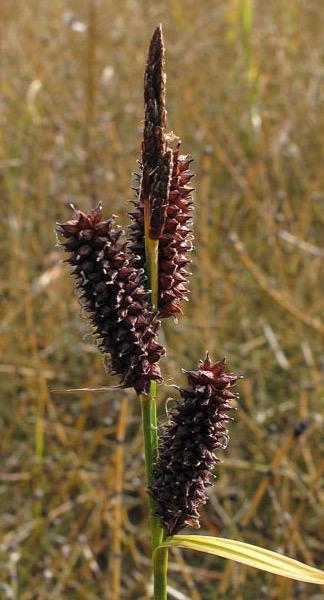
How does this make a difference to botanising? Well, for a start it cuts down the number of possibilities when trying to ID an unknown species. For example, while there are about 14 Rosa species in Britain as a whole, in Scotland only 8 of them are found. So, to save wasting a lot of time wondering whether your plant found in Perthshire is Ploughman's Spikenard Inulaconyzae, for example, check the field guide, app, or the Distribution Database database.bsbi.org/maps to discover the extreme unlikeliness of this event. If you really think you have found a Jersey Lily Amaryllis belladonna on Skye, the only thing to do is to take a lot of photos (not the plant or bits of it) and send them to someone who should know – the local vice-county recorder or the species referee as appropriate.
On the plus side, Scotland boasts some habitats that are rare to non-existent further south. Thus certain assemblages of species can be studied more readily here, especially montane species. The position of Scotland on the extreme north-western edge of Europe, with its oceanic climate, gives rise to unique assemblages in places like Skye. Alpine Gentian Gentiana nivalis (©Bert Barnett) and Alpine
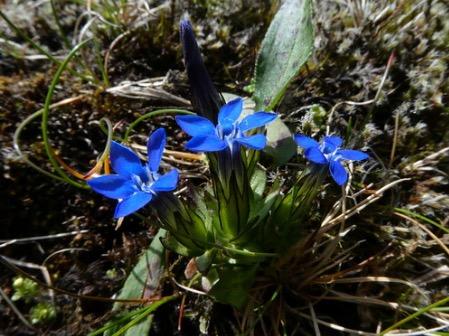
Milk-vetch Astragalus alpinus,for example, aren't found in Britain away from Scottish mountains., of which Ben Lawers is often felt to be the botanical star. In Orkney and on the far north mainland coast, the Scottish Primrose Primula scotica is one of very few plants endemic to Scotland. Sheer lack of disturbance (and perhaps pollution) in montane habitats must account for the presence of some species no longer commonly found in England.

A number of species are at the northern extreme of their range here. On the other hand, we are rather short of limestone pavements and grasslands. Limestone Woundwort – in spite of its scientific name Stachysalpina – is known only from a few not-very-mountainous places in England. With some species, the deciding factor seems, rather mysteriously, to be factors associated with latitude alone. Distribution of the Southern Downy Rose Rosa tomentosa and Northern Downy Rose Rosa mollis barely overlaps. The distribution of Dactylorhizapraetermissa Southern Marsh Orchid and D.purpurella Northern Marsh Orchid so far only overlaps in a small area of Northern England and North Wales – but the former is gradually moving farther north, clearly in response to climate change.
So what about climate change? Indeed, plant distribution is one of the clearest indicators we have of the alterations that are taking place from this cause. The Bee Orchid, for example, Ophrysapifera was not found in Scotland until this millenium but now is increasingly being recorded ever farther north. An alien from Peru, Shaggy Soldier Galinsogaquadriradiata used to be a denizen of urban areas only in the south, but is now being occasionally recorded even in Aberdeen and Inverness. Snow pearlwort Saginanivalis (©Sarah Watts) in contrast , is one of the montane species being to run out of room (see page 21). It may be that English and Scottish flora will in fact become more alike as the climate changes, so watch this space.
WHAT DO BOTANISTS DO ALL DAY?
